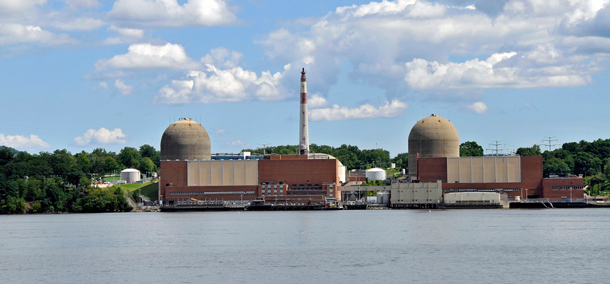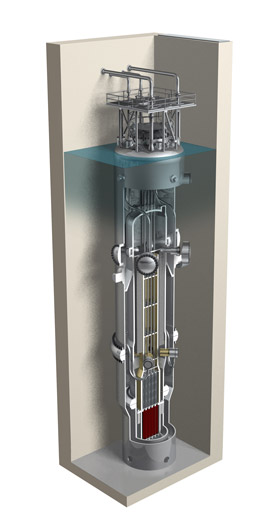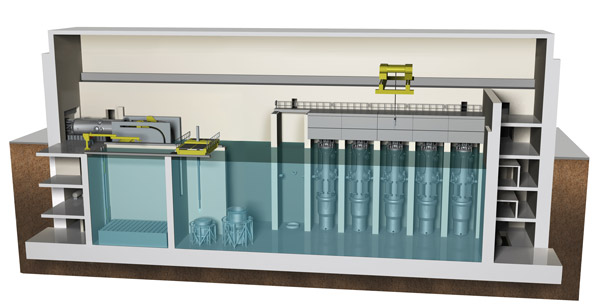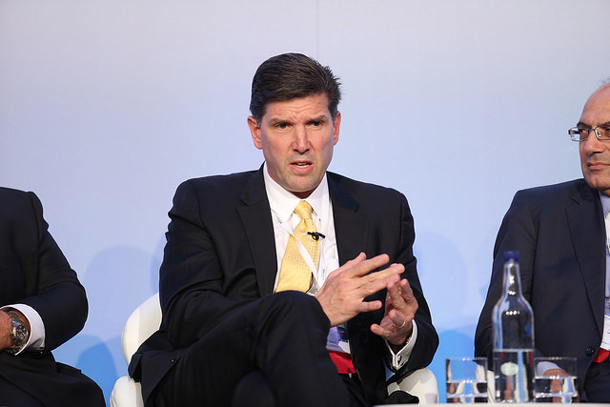US Hails Atomic Power At Climate COP23
Air Date: Week of November 10, 2017

A nuclear power plant and wind turbines work side-by-side in Drôme, France. (Photo: Jeanne Menjoulet, Flickr CC BY 2.0)
As global leaders meet for UN climate COP23 talks in Bonn, Germany, the U.S. delegation is promoting carbon-free nuclear energy as part of an “all of the above” strategy for climate protection. Department of Energy Acting Assistant Secretary Edward McGinnis tells host Steve Curwood that advanced nuclear technologies are safer than older systems and can provide base load support for power grids to balance intermittent renewable energy. He also reports the Trump Administration is partnering with US companies to be world leaders on atomic power.
Transcript
CURWOOD: From PRI, and the Jennifer and Ted Stanley Studios at the University of Massachusetts Boston, this is Living on Earth. I’m Steve Curwood.
Now that Syria has signed on to the Paris Climate Agreement, all nations are aboard, with only the US looking to jump ship. Even so, the US is still active in the UN Climate treaty sessions, and at this year’s meeting at Bonn it’s promoting an “all of the above” energy strategy, including carbon-free power systems that constantly pump out electricity, whatever the weather or time of day. That technology, of course, is nuclear, which today lights nearly every home in France and about a fifth of homes in America.
Of course atomic energy is not popular in many quarters because of costs, accidents, and controversies over waste. But the Trump administration is telling climate delegates that nuclear, especially advanced small reactors, can provide safe, secure and cost-effective base-load power that can integrate solar and wind in systems that emit zero carbon. Here to explain is Edward McGinnis, the Acting Assistant US Secretary of Energy for nuclear power.
MGGINNIS: I can tell you that nuclear energy is a key element of a clean agenda. Nuclear energy represents, for example, in the United States the single largest clean generating source of electricity. Sixty percent of all of our clean electricity generation is from nuclear power. The nuclear sector in the United States avoids over 600 million metric tons of carbon a year because of those plants operating. So, the nuclear fleet in the United States, the nuclear fleet globally, is a key element to our future clean energy needs.

Indian Point Nuclear Power Plant is among the latest old, 1970s-era nuclear power plants to be slated for retirement in the next few years. (Photo: Tony Fischer, Flickr CC BY 2.0)
CURWOOD: What's the message that the United States delegation is giving at the climate summit in Bonn?
MGGINNIS: Well, let me just step back and say what the message we're giving to not only the American citizens but our global partners and others around the world, and that is this administration has an all of the above policy and strategy for energy, and we want to see, and we do prioritize, having the cleanest portfolio possible, whether it's clean nuclear, whether it's renewables. We strongly support wind, we strongly support solar. We also strongly support clean coal. So, we believe that an energy mix that is robust and competitive, where we remove as much as possible government barriers and provide a business-friendly environment, is the way to go. I would also say, when you talk about the global stage, it's important to remind Americans that we have led and we continue to lead in the reduction of carbon. In fact, we are the world's leader in reducing carbon by any country in the world in the past 10 years, and we're proud of that and we're going to continue to support that.
CURWOOD: Now Ed, I'd imagine that a number of people listening to us right now are skeptical. In fact, they might even think that we're nuts to be talking about nuclear power their, their view is the stuff that you use for nuclear power you can make weapons out of. We haven't solved the waste problem. In fact, we have international tension with other countries because of nuclear fuel issues. How do you respond to that kind of skepticism?
MGGINNIS: Nuclear energy has been demonstrated since the ’50s as being able to be used in a peaceful secure way. I have no doubt that the nuclear industry will be around in the future with or without US leadership and I want to be with US leadership. The best way to answer those critics as to what we should do to ensure that it is being used for peaceful purposes is to take the country that has bar none the highest commitment on nonproliferation, bar none the highest level of safety of any other market in the world - That's the United States - to have us be in a leadership role. It's our leadership that will be a key, key aspect to ensuring that nuclear energy continues to be used by the vast majority of the countries - the thirty countries that have nuclear - to use it peacefully.

A single Small Modular Reactor (SRM) module design, as conceived by NuScale Power, which is working with the Department of Energy to bring its advanced reactor system concept into commercial use by 2026. (Photo: courtesy of NuScale Power)
CURWOOD: And how does the US nuclear program compare to our competitors? I'm thinking particularly of China, which is, I think, the world's fastest expanding nuclear power producer, and what in your view needs to be done to secure America's competitive advantage?
MGGINNIS: That's a great point. The nuclear sector is a highly competitive sector globally. Korea won one of the biggest nuclear deals in recent memory, and that was back a number of years ago in the UAE. When they won that, it was described as a $20 to $30 billion dollar deal. These are big, big deals. When you're supplying a reactor and fuel to a country, and a reactor is going to operate for maybe 60 years, and you're almost talking about a 100-year relationship, and so it's not only jobs that China, Russia, and others who are major competitive suppliers, it's not just the economic benefit, it's the strategic benefit that is gained when they win these contracts.
So, certainly we are very focused on maintaining US global commercial nuclear leadership. Our competitors are almost all state-owned corporations. The United States government therefore, we do everything we can to support in an advocacy role our American companies to be able to compete effectively with these large, state-owned corporations. I have no doubt that we can compete and win because we have products, and we have technologies, and we have business approaches that are unmatched by any of the state-owned corporations. I have no doubt. But the challenge is to give an even, level playing field for our companies to effectively compete and win.
CURWOOD: Many of the nuclear power reactors around America and indeed the world today are based on pretty old technology. What's coming in terms of advanced technology that you think would increase the confidence of the public that it can be safe and cost effective?

A design of an SRM reactor building showing multiple modules. (Photo: courtesy of NuScale Power)
MGGINNIS: We have advanced reactors including advanced small modular reactors. In particular, one that is already working its way through the Nuclear Regulatory Commission’s design licensing process, the first, first ever advanced small modular reactor that has been accepted and being reviewed by the NRC with a timeline of 2026 in the United States to be commercially operated. And this particular advanced reactor and a number of others bring some key game changers. One is passively safe, walk-away reactors. What I mean by that is if you had a complete loss of power offsite power these reactors automatically shut down without any human intervention, without any motors or pumps. They have step-change improvements in efficiency, and also they have the potential significantly for a great deal of different applications, not just power generation but de-salinization for petrochemical.
There's one very exciting approach we're looking at now. We call it the hybrid approach, where we are looking at small modular reactors paired up with a solar plant, paired up with a wind turbine plant, and that is a real potential winning combination, base-load nuclear power clean with a renewable plant like solar or wind. And we're actively looking with our national laboratories at that hybrid approach. So, we have some real game changing technologies that, I think, change the landscape and even, frankly, perception of nuclear reactors.
CURWOOD: What would be the advantage of what you call a hybrid approach? Folks listening to us might say, “Hey, what about solar and wind? They're cheap and they're quick.”
MGGINNIS: Sure, well as much as I love solar and wind, the problem is at night you have no sun, you're not going to get power from the solar plant. When the wind is not blowing, you're not going to get power from the wind turbine plants. From a resiliency perspective nuclear power is key. Secretary Perry has launched a very, very important national discussion because we need to make sure that we have a resilient electricity grid to ensure our citizens always have access to power. Not just when things are going well, but dead of winter or in the middle of the summer, whether it's a polar vortex or a hurricane coming, we want to make sure that we have base-load power. Renewables, intermittent sources as we described, will not be enough.
CURWOOD: How do we deal with the waste problem with nuclear power?
MGGINNIS: I can tell you how we need to deal with it. We need to deal with it as this administration has done, and that is we need to stop kicking the can. We have to absolutely take responsibility. It's our moral obligation to find once and for all a path forward for dispositioning that spent nuclear fuel that we have already committed to doing. So, we submitted in the 2018 budget a substantial request for Congress to appropriate, that would allow us to now promptly resume the licensing for the Yucca Mountain application in the NRC as well as concurrently move out on a robust interim storage. So, Secretary Perry, I strongly, the administration, feels very much it is our obligation we need to do this on behalf of the American people.

Edward McGinnis is Acting Assistant Secretary for Nuclear Energy at the US Department of Energy. (Photo: World Nuclear Association, Flickr CC BY-ND 2.0)
CURWOOD: The big challenge for nuclear power has been financing. Wall Street hasn't seemed terribly interested, and taxpayers have had to guarantee loans. And there's a concern that the market doesn't seem to like it. Your response?
MGGINNIS: Well, first and foremost, it's almost a chicken and the egg. If a market, as we've seen certainly in the past number of years, has a government policy that is not clear and not consistent on nuclear energy, that sends a chilling effect on potential investors. If you have a market that is favoring one source, such as renewables, over another and creating negative pricing, that scares away investors.
The advanced small modular reactors, in my view, in Secretary Perry's view, is a potential game changer. A couple of reasons why: one is financing. A typical large reactor of the type we have in the United States now and around the world…Basically you have a choice and around the world of large or larger reactors. One reactor will cost you on average $8 billion dollars before financing, and most like to order two units, so we're talking about $14 billion before financing.
Most utilities do not have much larger of a market cap in that entire price tag, and so small modular reactors, they're going to come in let's say 50 megawatts each and it can go up to 12, you know, a 12 pack for 50 megawatts electric each. The ability to secure $750 million or a billion dollars to get that initial bite at the apple, to build that initial capacity, the ability to then start selling that electricity generating the revenue to then take the second bite to finance the second unit on and on, that's a game changer.
CURWOOD: Edward McGinnis is the Acting Assistant Secretary of Energy for Nuclear Power at the Department of Energy. Thank you so much, Sir, for taking the time today.
MGGINNIS: Thank you very much it's my pleasure.
Links
NYTimes: “Trump Team to Promote Fossil Fuels and Nuclear Power at Bonn Climate Talks”
Department of Energy’s Office of Nuclear Energy
Living on Earth wants to hear from you!
Living on Earth
62 Calef Highway, Suite 212
Lee, NH 03861
Telephone: 617-287-4121
E-mail: comments@loe.org
Newsletter [Click here]
Donate to Living on Earth!
Living on Earth is an independent media program and relies entirely on contributions from listeners and institutions supporting public service. Please donate now to preserve an independent environmental voice.
NewsletterLiving on Earth offers a weekly delivery of the show's rundown to your mailbox. Sign up for our newsletter today!
 Sailors For The Sea: Be the change you want to sea.
Sailors For The Sea: Be the change you want to sea.
 The Grantham Foundation for the Protection of the Environment: Committed to protecting and improving the health of the global environment.
The Grantham Foundation for the Protection of the Environment: Committed to protecting and improving the health of the global environment.
 Contribute to Living on Earth and receive, as our gift to you, an archival print of one of Mark Seth Lender's extraordinary wildlife photographs. Follow the link to see Mark's current collection of photographs.
Contribute to Living on Earth and receive, as our gift to you, an archival print of one of Mark Seth Lender's extraordinary wildlife photographs. Follow the link to see Mark's current collection of photographs.
 Buy a signed copy of Mark Seth Lender's book Smeagull the Seagull & support Living on Earth
Buy a signed copy of Mark Seth Lender's book Smeagull the Seagull & support Living on Earth

